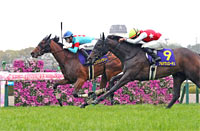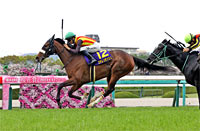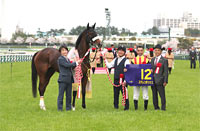2015 Oka Sho (Japanese 1000 Guineas) (G1) - Preview

 Hanshin Racecourse
Amid the fantastic explosion of pink around the nation comes the fanfare of the filly classics, the first race of the filly’s Triple Crown – the Oka Sho, or “Cherry Blossom Prize.” Sunday, April 12 will mark the 75th running of the mile tradition now hosted by Hanshin Racecourse. This year’s lineup is an exceptional one.
After last year’s departure from the recent trend, a departure that saw the focus on the Hanshin Juvenile Fillies top finishers, this year’s ranks are once again dotted with exciting new names that have emerged afterward, from the Oka Sho preps and trials.
With the winner of the Juvenile Fillies – Shonan Adela – out after a fracture suffered in mid March, the spotlight has moved to the runnerup and third-place finisher of the Juvenile Fillies – Kokorono Ai and Let’s Go Donki. Nether of the two, though they are expected to figure in the top picks, are expected to be the favorite. That honor is likely to go to the G3 Kisaragi Sho champion Rouge Buck, unbeaten from three starts and proven against colts. There will also be considerable competition from other fillies, also unbeaten, such as Cat Coin and Queens Ring, winners of the G3 Daily Hai Queen Cup and the G2 Hochi Hai Fillies’ Revue, respectively. The G3 Tulip Sho is also seen as a strong indicator of success in the Oka Sho, which means runnerup Andriette will also be favored.
The Oka Sho is open only to 3-year-old females and carries a first-place bounty of 89 million yen, a total purse of nearly 185 million yen. The race is run over the Hanshin 1,600-meter outer course and is the shortest of the Triple Crown trio.
The race was modeled after the English 1000 Guineas and was first held in 1939 at Nakayama Racecourse over 1,800 meters, then moved to Kyoto in 1947 and shortened to its current distance of a mile. The race was then relocated to Hanshin in 1950.
The Hanshin 1,600 over the outer track starts in the backstretch and continues straight for 444 meters. The sweeping turn covers more than 680 meters and the field, which tends to stay tight from the gate, continues tight around the bend. In general, inside draws are favored. The stretch has a hill starting from 200 meters out that rises 1.8 meters over 100 meters. This hill makes the course a bit easier than the Kyoto 1,600 for horses that remain just off the pace to move up the ranks in the long drive home.
Over the past 10 years, the Oka Sho has been captured largely by fillies stabled at the western training center of Ritto. Seven Ritto-based fillies have won. The proximity to Ritto and prior experience at Hanshin are strong factors in predicting success in the Oka Sho. However, this year, with the Masahiro Otake-trained Rouge Buck, as well as Cat Coin and Kokorono Ai all hailing from Miho, Kanto is considered to have an excellent shot at victory.
The Oka Sho gained G1 status in Japan in 1984 and received international Grade 1 status in 2010. The top four finishers from a full field of 18 will automatically qualify for the second leg of the filly’s Triple Crown -- the 2,400-meter Yushun Himba (Japanese Oaks) on May 24 at Tokyo.
The Oka Sho top picks often live up to expectations and finish in the money. The favorite has won three times in the last 10 runnings and finished in the top three spots seven times over the past decade. Longshots, however, are not ruled out. Five times in the past decade, a double-digit at the windows have made the money. Once, in 2008, the longshot Reginetta won the race. She was 12th pick and paid 4,340 yen on a 100 yen wager to win. In comparison, last year’s winner, the race favorite Harp Star, returned 120 yen on 100 yen to win.
Apapane in 2010 set the current Oka Sho record with a time of 1 minute, 33.3 seconds.
The Oka Sho is the 11th race on the Hanshin Sunday card. Post time is 3:40 p.m. Here is a look at the expected top choices.
|

Rouge Buck Rouge Buck – Despite her name, Rouge Buck is indeed a filly. But from the looks of her three starts thus far, she can and has held her own against the boys. In fact, she’s beaten them. Three for three, she has run against colts in all her starts. In her second start, the Hyakunichiso Tokubetsu, she topped (by 2 ½ lengths) a field of 10 that included eight colts, including the G3 Keisei Hai winner Beruf. And, her winning time of 2:00.8 was a 2-year-old course record. Last time out, after a leap up in class to the G3 Kisaragi Sho at Kyoto, she topped a field of eight that included six colts by 2 lengths. And, with this Manhattan Cafe filly, most of the usual questions that crop up concerning lightly raced youngsters have already been answered. This girl can race from a forward position or the rear. She’s shown she can handle a clockwise track or a counterclockwise one. She has also handled the long trip from her home-base Miho to the west without a hitch. Having run over distances of 1,800 and 2,000 meters, the only question that remains is whether she can handle her first mile with equal aplomb. With the pace of this year’s Oka Sho expected to be a leisurely one, Rouge Buck shouldn’t have a problem. Neither should she have a problem with the haul to Hanshin, according to her trainer. Otake says, “On her trip to Kyoto, she kept eating well and didn’t lose weight. She also settled well even without cover, yet won strongly against colts.” He says too that the mile is within her ability. “She’s a good starter, so she should handle 1,600.” |
|

Cat Coin Cat Coin – Winner of the G3 Daily Hai Queen Cup, the Stay Gold–sired Cat Coin settles well and has great acceleration. She’s still somewhat shaky on her starts but it hasn’t stopped her from winning all of her three outings to date. Her appetite, however, is a bit shaky as well and so she has been handled with care, debuting only last October and with only the one race so far this year. Nonetheless, her work a week out looked good and she is in fine shape. Though it will be Cat Coin’s first time at Hanshin, she has experience over a right-handed track and a long straight. All her starts have been over 1,600 meters. She is trained by the Miho-based Yoshitaka Ninomiya, who moved Cat Coin to Ritto on March 28 to prepare for the Oka Sho nearby. Ninomiya also trains Shonan Adela. With that filly sidelined, Ninomiya’s hopes are undoubtedly firmly on his “Cat.” |
|

Kokorono Ai Kokorono Ai – Another outstanding 3-year-old daughter of Stay Gold is Kokorono Ai, from the stable of the Miho-based Tomohito Ozeki. The bay filly has been consistently in the money, having won three of her five starts and finishing second and third in the other two. Despite worries about her ability to settle, Kokorono Ai did fine last time out coming off a layoff and captured the G3 Tulip Sho at Hanshin on March 7. This Oka Sho trial is considered one of the best predictors of success for the Oka Sho. Kokorono Ai was third in the G1 Hanshin Juvenile Fillies last year after winning her previous start the G3 Artemis Stakes. Kokorono Ai is trustworthy over all sorts of going. She has won on firm, good and yielding tracks and has been raced predominately at the mile. Kokorono Ai has also made the trip to Ritto early. “She has settled in and is eating well,” says Ozeki. |
|

Queens Ring Queens Ring – Another filly unbeaten at three starts, another daughter of Manhattan Cafe, is Queens Ring. Her first race only came at the end of last year, like Rouge Buck, she jumped from a lower-class race to the win of a graded stakes race, namely the 1,400-meter G2 Hochi Hai Fillies’ Revue at Hanshin on March 15. Queens Ring’s first two starts saw her partnered with Gregory Benoist. She won the Fillies’ Revue under Mirco Demuro, who is slated for the ride Sunday. Queens Ring, besides having started slowly in her last two races, has been drawn wide in all her three starts. The draw, coupled with her late breaks, have seen her forced wide in her last two races, but nonetheless she was an easy winner. Each race she has taken on a new distance without a problem and each race has seen her turn in fast times in the final stages. Queens Ring weighed in for the 1,400-meter G2 Fillies’ Revue weighing 20 kg less than she had for her previous race in January, but she blasted out the final 3 furlongs at a blistering 34.9 seconds, 0.3 seconds slower than her last two starts. “Not only did the win get her into the Oka Sho,” says trainer Keiji Yoshimura, “but it was a great gain to see that she could run on the outside and still be successful, on a day that was favoring the inside.” The longer stretch of the Hanshin outer course this time should prove a plus, as will the extra furlong. |
|

Let’s Go Donki Let’s Go Donki – Though she has only one win from six starts, Let’s Go Donki has made the money in every race, all but one are graded races. After acing her debut, the daughter of King Kamehameha took on the G3 Sapporo Nisai Stakes and scored third. Next up was the Artemis Stakes and a second-place finish. She then ran second in the G1 Juvenile Fillies missing the win by half a length. Coming back after a layoff, she ran third in the Tulip Sho 2 lengths behind the winner. The concern with Let’s Go Donki is her trouble settling. She moved quickly to the head of the field in the Tulip Sho, and considering the pace, third was no great accomplishment, but considering she was coming off a layoff and asked to lead for the first time, it’s far too early to write this gal off. Trainer Tomoyuki Umeda says her “responses and breathing were good” in last week’s fast work and that her last start has sharpened her considerably. |
|

Andriette Andriette – Andriette won her ticket to the Oka Sho with her second-place finish in the Tulip Sho and she managed to cross the line only 0.2 seconds behind the winner. It was quite a feat considering she broke late from the No. 1 gate, raced in the rear and found herself behind a wall going into the top of the turn. Brought wide, she rocketed up the stretch clocking 35.7 seconds over the last 600 meters on a heavy track and missed the win by a length and a quarter. Deep Impact fillies have captured the last four runnings of the Oka Sho – Marcellina in 2011, Gentildonna in 2012, Ayusan in 2013 and Harp Star last year. Deep Impact progeny tend to favor a fast track, however. Given her second in the Tulip Sho, Andriette may be worth a wager if the going is less than firm on Sunday. And, with the race close to Ritto this time, trainer Kazuya Makita says his filly should fare better than she had for the Queen Cup at Tokyo two races ago. “She’d lost weight after that long haul, but this time it’ll be a short trip and that is a plus.” |
|

Mikki Queen Mikki Queen – After winning her second start, the Deep Impact-sired Mikki Queen jumped up in class to take on the G3 Queen Cup on Feb. 14 at Tokyo. She registered a 20-kg drop in weight from the trip east and was slow out of the gate, but ran second, only missing the win by a neck to Cat Coin. It was a performance that indicates she has considerable talent to draw on. Mikki Queen also, when she broke her maiden, demonstrated she can handle the Hanshin mile. However, she must first win a berth in the Oka Sho, Mikki Queen is one of three, along with Earthrise and Loaded, vying for the last two slots in the Oka Sho lineup. |
|

Culminar Culminar – A Deep Impact filly from the stable of Naosuke Sugai, Culminar has two wins from three starts. She jumped to the open class from her debut and from those two wins (both over firm ground) to the G3 Tulip Sho. Expectations were high enough to make Culminar the favorite, but a combination of factors -- a slow break, the ensuing rearward position, traffic and a yielding track -- resulted in a disappointing 11th-place finish. Those factors, however, are enough to cancel the race out as indicative of this filly’s talent. What one would be wise to note were her fraction times over the last 600 meters – 11.2-11.2-11.5 – which should remind one of the 2 lengths by which she won her race previous. “She’s relaxed and that’s a plus,” says Sugai. “The competition will be even stronger but I’m expecting her to rally. If she can get a smooth run on a fast track, I think she’ll be able to show her power.” |
|

Tenderly Voice Tenderly Voice – Third in the G3 Fairy Stakes and coming off a win of the open-class Anemone Stakes at Nakayama on March 14 is Tenderly Voice, another Deep Impact filly that has shown promise and consistency with two wins, two seconds and a third from six starts. She has, however, yet to win at the graded level. It will be her first time at Hanshin and her first trip westward. Though she has been successful at Nakayama, the long stretch at Hanshin may prove too high a hurdle. |
|

- Preview
- Barrier draw
- Past performances of runners

- News
- Race result
- Video
- 2025 English

- 2024 English

- 2023 English

- 2022 English

- 2021 English

- 2020 English

- 2019 English

- 2018 English

- 2017 English

- 2016 English

- 2015 English

- 2014 English

- 2013 English

- Photo Gallery
2025 Winner: Embroidery


2024 Winner: Stellenbosch


|






























